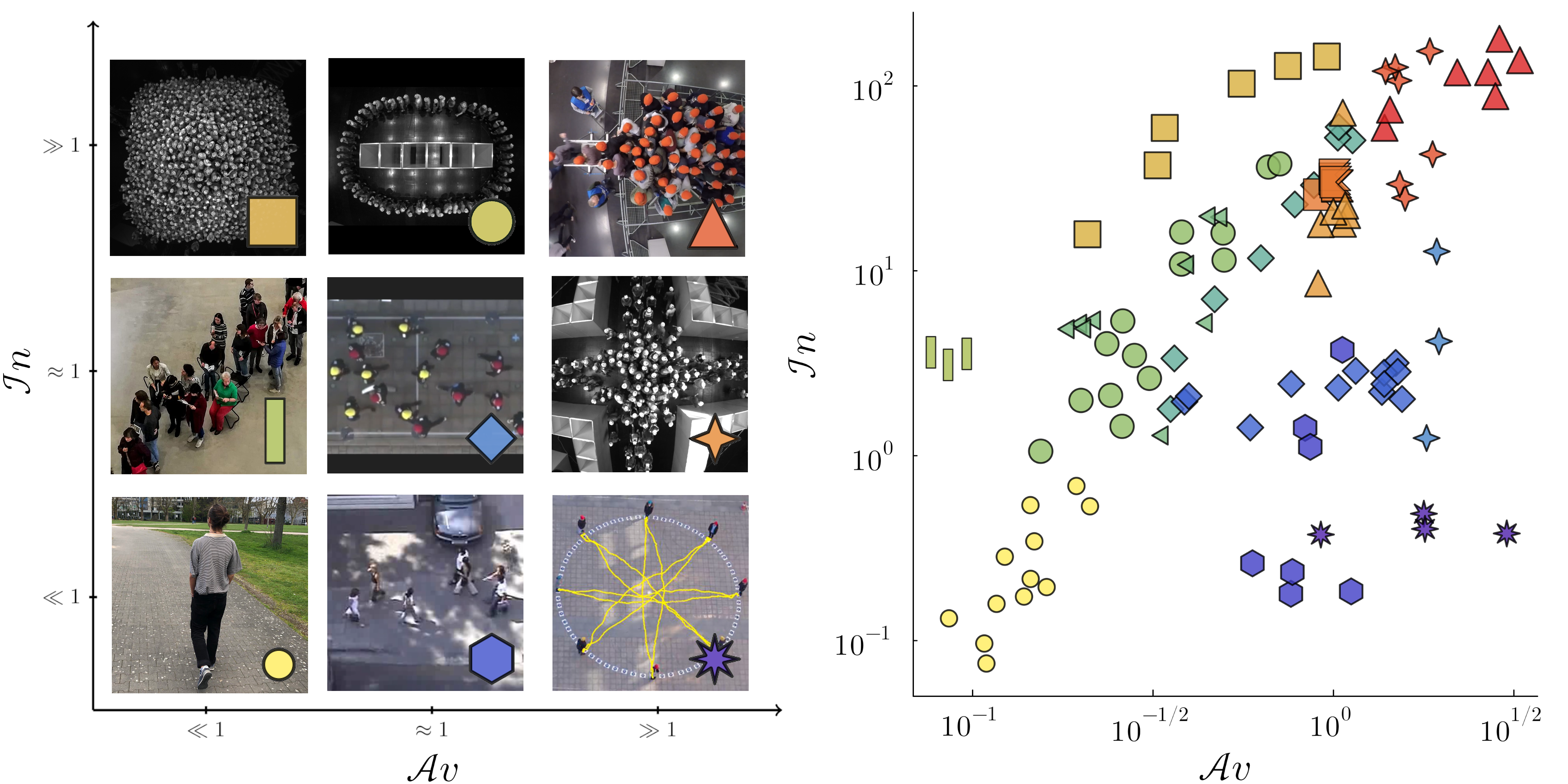Classification of Pedestrian Crowds by Dimensionless Numbers
DOI:
https://doi.org/10.17815/CD.2024.164Keywords:
Pedestrians, Modelling, Dimensionless numbers, Collision avoidanceAbstract
Presently, classifications of pedestrian crowds primarily rely on density. This fails to encompass the diverse behaviours and risk profiles observed. We introduce two dimensionless numbers, the Intrusion number In, based on the desire to maintain one’s personal space, and the Avoidance number Av, based on the anticipation of collisions. These two numbers delineate different flow regimes, as we intuitively expect and as we empirically demonstrate using an extensive dataset. Similarly to Fluid Mechanics, where dimensionless numbers guide the choice between different approximations, the dynamics of crowds can be approached in each regime by perturbative expansions, which yield pedestrian models applicable in the corresponding regime (and only there).
References
Fruin, J.: Pedestrian Planning and Design. Metropolitan Association of Urban Designers and Environmental Planners, New York (1971)
Feliciani, C., Shimura, K., Nishinari, K.: Introduction to Crowd Management. Springer, Cham, Switzerland (2021)
Zanlungo, F., Feliciani, C., Yücel, Z., Jia, X., Nishinari, K., Kanda, T.: A pure number to assess "congestion" in pedestrian crowds. Transportation Research Part C: Emerging Technologies 148, 104041 (2023). doi:10.1016/j.trc.2023.104041
Cordes, J., Nicolas, A., Schadschneider, A.: Dimensionless Numbers Reveal Distinct Regimes in the Structure and Dynamics of Pedestrian Crowds. PNAS Nexus p. pgae120 (2024). doi:10.1093/pnasnexus/pgae120. URL https://doi.org/10.1093/pnasnexus/pgae120
Sorokowska, A., Sorokowski, P., Hilpert, P., Cantarero, K., Frackowiak, T., Ahmadi, K., Alghraibeh, A.M., Aryeetey, R., Bertoni, A., Bettache, K., et al.: Preferred interpersonal distances: A global comparison. Journal of Cross-Cultural Psychology 48(4), 577-592 (2017)
Hall, E.T., Hall, E.T.: The hidden dimension, vol. 609. Anchor (1966)
Meerhoff, L.A., Bruneau, J., Vu, A., Olivier, A.H., Pettré, J.: Guided by gaze: Prioritization strategy when navigating through a virtual crowd can be assessed through gaze activity. Acta psychologica 190, 248-257 (2018)
Seyfried, A., Portz, A., Schadschneider, A.: Phase Coexistence in Congested States of Pedestrian Dynamics. In: Bandini, S., Manzoni, S., Umeo, H., Vizzari, G. (eds.) Cellular Automata, vol. 6350, pp. 496-505. Springer Berlin Heidelberg, Berlin, Heidelberg (2010). doi:10.1007/978-3-642-15979-4_53
Adrian, J., Seyfried, A., Sieben, A.: Crowds in front of bottlenecks at entrances from the perspective of physics and social psychology. Journal of The Royal Society Interface 17(165), 20190871 (2020). doi:10.1098/rsif.2019.0871
Cao, S., Seyfried, A., Zhang, J., Holl, S., Song, W.: Fundamental diagrams for multidirectional pedestrian flows. Journal of Statistical Mechanics: Theory and Experiment 2017(3), 033404 (2017). doi:10.1088/1742-5468/aa620d
Feliciani, C., Murakami, H., Nishinari, K.: A universal function for capacity of bidirectional pedestrian streams: Filling the gaps in the literature. PLOS ONE 13(12), e0208496 (2018). doi:10.1371/journal.pone.0208496
Murakami, H., Feliciani, C., Nishiyama, Y., Nishinari, K.: Mutual anticipation can contribute to self-organization in human crowds. Science Advances 7, eabe7758 (2021). doi:10.1126/sciadv.abe7758
Xiao, Y., Gao, Z., Jiang, R., Li, X., Qu, Y., Huang, Q.: Investigation of pedestrian dynamics in circle antipode experiments: Analysis and model evaluation with macroscopic indexes. Transportation Research Part C: Emerging Technologies 103, 174-193 (2019). doi:10.1016/j.trc.2019.04.007
Nicolas, A., Kuperman, M., Iba nez, S., Bouzat, S., Appert-Rolland, C.: Mechanical response of dense pedestrian crowds to the crossing of intruders. Scientific Reports 9(1), 105 (2019). doi:10.1038/s41598-018-36711-7
Boomers, A.K., Boltes, M., Adrian, J., Beermann, M., Chraibi, M., Feldmann, S., Fiedrich, F., Frings, N., Graf, A., Kandler, A., Kilic, D., Konya, K., Küpper, M., Lotter, A., Lügering, H., Müller, F., Paetzke, S., Raytarowski, A.K., Sablik, O., Schrödter, T., Seyfried, A., Sieben, A., Üsten, E.: Pedestrian Crowd Management Experiments: A Data Guidance Paper. Collective Dynamics 8, 1-57 (2023). doi:10.17815/CD.2023.141
Seyfried, A., Steffen, B., Klingsch, W., Boltes, M.: The fundamental diagram of pedestrian movement revisited. J. Stat. Mech. P10002 (2005). doi:10.1088/1742-5468/2005/10/P10002
Karamouzas, I., Skinner, B., Guy, S.J.: A universal power law governing pedestrian interactions. Phys. Rev. Lett. 113(5), 238701 (2014). doi:10.1103/PhysRevLett.113.238701
van Toll, W., Grzeskowiak, F., Gandía, A.L., Amirian, J., Berton, F., Bruneau, J., Daniel, B.C., Jovane, A., Pettré, J.: Generalized Microscropic Crowd Simulation using Costs in Velocity Space. In: Symposium on Interactive 3D Graphics and Games, pp. 1-9. ACM, San Francisco CA USA (2020). doi:10.1145/3384382.3384532
Hoogendoorn, S., Bovy, P.: Simulation of pedestrian flows by optimal control and differential games. Optim. Control Appl. Meth. 24, 153 (2003). doi:10.1002/oca.727
Guy, S.J., Curtis, S., Lin, M.C., Manocha, D.: Least-effort trajectories lead to emergent crowd behaviors. Physical Review E 85(1), 016110 (2012). doi:10.1103/PhysRevE.85.016110
Supplemental videos. https://youtu.be/E8NvgRLPvLg
Helbing, D., Farkas, I., Vicsek, T.: Simulating dynamical features of escape panic. Nature 407, 487-490 (2000)
Tordeux, A., Chraibi, M., Seyfried, A.: Collision-Free Speed Model for Pedestrian Dynamics. In: Knoop, V.L., Daamen, W. (eds.) Traffic and Granular Flow '15, pp. 225-232. Springer International Publishing, Cham (2016). doi:10.1007/978-3-319-33482-0_29
van den Berg, J., Lin, M., Manocha, D.: Reciprocal Velocity Obstacles for Real-Time Multi-Agent Navigation. In: Robotics and Automation, 2008. ICRA 2008. IEEE International Conference On. 2008 IEEE International Conference on Robotics and Automation Pasadena, CA, USA, May 19-23, 2008 (2008)
van den Berg, J., Guy, S., Lin, M., Manocha, D.: Reciprocal n-Body Collision Avoidance. In: Springer Tracts in Advanced Robotics, vol. 70, pp. 3-19 (2011)

Downloads
Published
How to Cite
Issue
Section
Categories
License
Copyright (c) 2024 Jakob Cordes, Alexandre Nicolas, Andreas Schadschneider

This work is licensed under a Creative Commons Attribution 4.0 International License.
Authors contributing to Collective Dynamics agree to publish their articles under the Creative Commons Attribution 4.0 license.
This license allows:
Share — copy and redistribute the material in any medium or format
Adapt — remix, transform, and build upon the material
for any purpose, even commercially.
The licensor cannot revoke these freedoms as long as you follow the license terms.
Authors retain copyright of their work. They are permitted and encouraged to post items submitted to Collective Dynamics on personal or institutional websites and repositories, prior to and after publication (while providing the bibliographic details of that publication).








